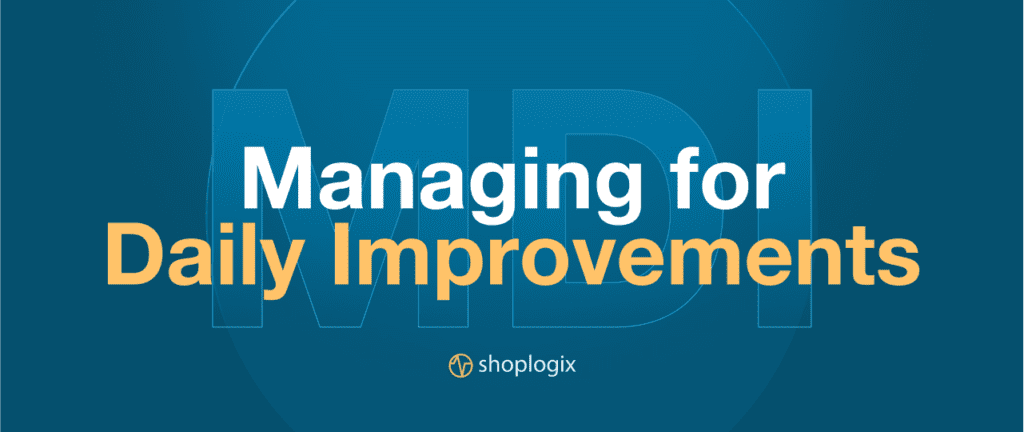Managing for Daily Improvement (MDI) stands out as a key strategy for businesses, focusing on clarity through visuals, tracking key performance indicators (KPIs), and building a culture of continuous improvement from the grassroots level. This guide explores the significant impact MDI can have on manufacturing operations, showcasing its remarkable influence through expert insights.
What Does Managing for Daily Improvement Mean?
MDI transcends traditional management approaches by embedding accountability and problem-solving within the daily activities of employees. It’s a methodology that brings visual management and daily huddles to the forefront, ensuring real-time problem resolution and engagement from all team members. The use of the Socratic Method during these huddles encourages critical thinking and maximal participation, making problem areas visible and actionable immediately.
A significant shift MDI brings is the empowerment of employees to own the improvement process. It seamlessly integrates the strategic plan with daily operations, fostering a habit of performance management that permits quick adjustments. This bottom-up approach ensures that strategic goals are met through everyday tasks, making continuous improvement an organizational norm.
Managing for Daily Improvement in Action
Grasping the essence of MDI becomes clearer when we see it operational within a business context. Imagine this scenario: every day, an operations team gathers to review their previous day’s goals alongside the outcomes they achieved. Should they encounter any obstacles that hampered their progress, they collectively examine and tackle these issues head-on. This problem-solving session allows them to refine their processes, setting the stage for better results moving forward.
Team members share responsibilities, ensuring that solutions are not only identified but also recorded. This ensures everyone is on the same page regarding the chosen strategy. The team then divides tasks, with each member playing a crucial role in executing the plan within a designated timeframe. When challenges arise that surpass the team’s capacity, they escalate the issue to management for further guidance.
The spirit of MDI fosters a robust team dynamic, significantly boosting morale. It’s built on the premise of enhancing performance, productivity, and efficiency by empowering employees to initiate change from the ground up. Through MDI, teams evolve into self-managing units of proactive thinkers and problem-solvers, embodying the very essence of continuous improvement.

Implementing MDI
Implementing an effective MDI system requires a comprehensive approach that addresses both the technical and cultural aspects of the organization. Key elements include:
- Customizable KPIs: Manufacturers can tailor the MDI board to track relevant KPIs that align with their strategic objectives, such as reducing cycle time, improving product quality, or decreasing downtime.
- Real-Time Production Schedules: The ability to update production schedules in real-time ensures that everyone is aware of current priorities, deadlines, and changes, minimizing confusion and maximizing efficiency.
- Targets and Benchmarks: Setting clear targets and benchmarks, and making them visible to all team members, encourages a collective effort towards achieving common goals.
- Layered Process Audits and Kamishibai Boards: Incorporating quality-focused elements, such as Layered Process Audits and Kamishibai boards, empowers workers to maintain consistent quality standards and address issues proactively.
- Leadership Commitment: Successful implementation of MDI requires active participation and commitment from leadership, who must demonstrate their dedication to fostering a culture of continuous improvement.
The Advantages of MDI
Implementing a Managing for Daily Improvement system offers a variety of benefits that can significantly enhance manufacturing operations. Here are some of the key advantages:
Cost Reduction
- MDI impacts the bottom line directly by eliminating wasteful practices through clear visualization of processes.
- Streamlining operations leads to reduced expenses, allowing for savings that can be reinvested in business growth and innovation.
Enhanced Productivity
- Improves the flow of information, facilitating the swift identification and resolution of bottlenecks and inefficiencies.
- Real-time problem-solving ensures smoother operations, resulting in higher output and improved product quality.
Fosters Collaboration and Continuous Improvement
- The MDI board acts as a centralized communication hub, enhancing transparency and encouraging open discussions about operational challenges and successes.
- Promotes a culture where every team member feels a sense of ownership and accountability, leading to increased engagement and a collective drive towards ongoing improvement and problem-solving.
These benefits collectively contribute to creating a more efficient, productive, and motivated manufacturing environment, underscoring the value of integrating MDI into daily operations.
Managing for Daily Improvement X Lean Six Sigma
At the crossroads of Managing for Daily Improvement (MDI) and Lean Six Sigma (LSS), there’s a powerful synergy that transforms how organizations approach improvements. MDI empowers teams at the grassroot level by integrating visual management and daily goal setting, leveraging the natural desire of employees to excel. This bottom-up approach not only boosts morale but also turns every team member into a key player in driving change.
Imagine a scenario where managers of independent units leverage MDI to foster empathy and collaboration across teams, breaking down silos and uniting efforts. This is where LSS comes into play, providing the tools and methodologies needed to fine-tune processes and achieve operational excellence.
To activate this powerful combination:
- Start with daily team meetings to review goals and outcomes.
- Identify and document root causes of any deviations from goals.
- Assign clear responsibilities and deadlines for implementing solutions.
- Escalate unresolved challenges, with leadership stepping in to guide towards resolution.
This approach not only elevates employee engagement and performance but also shifts managers from fire-fighting modes to strategic thinking. Through MDI and LSS, organizations can cultivate a proactive culture of continuous improvement, with teams leading the charge from the ground up.
The Bottom Line
Managing for Daily Improvements is much more than a methodology; it’s a transformational approach that drives continuous improvement and operational excellence in manufacturing. By focusing on visual management, employee empowerment, and daily problem-solving, MDI enables organizations to achieve sustainable improvements and foster a culture of excellence. Adopting MDI means not just meeting today’s challenges but being well-prepared for tomorrow’s opportunities.
What You Should Do Next
Explore the Shoplogix Blog
Now that you know more about Managing for Daily Improvements, why not check out our other blog posts? It’s full of useful articles, professional advice, and updates on the latest trends that can help keep your operations up to date. Take a look and find out more about what’s happening in your industry. Read More
Request a Demo
Learn more about how our product, Smart Factory Suite, can drive productivity and overall equipment effectiveness (OEE) across your manufacturing floor. Schedule a meeting with a member of the Shoplogix team to learn more about our solutions and align them with your manufacturing data and technology needs. Request Demo
















